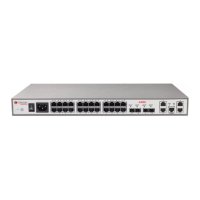A10E/A28E/A28F Configuration Guide
SwitchA#show interface port 2 vlan-mapping add-outer
Based inner VLAN QinQ mapping rule:
Port Original Inner VLAN List Add-outer VLAN Hw Status Hw-ID
---------------------------------------------------------------------
2 100-150 1000 Enable 1
SwitchA#show interface port 3 vlan-mapping add-outer
Based inner VLAN QinQ mapping rule:
Port Original Inner VLAN List Add-outer VLAN Hw Status Hw-ID
---------------------------------------------------------------------
3 300-400 2000 Enable 2
2.4 VLAN mapping
2.4.1 Introduction
VLAN Mapping is mainly used to replace the private VLAN Tag of Ethernet packets with
ISP's VLAN Tag, making packets transmitted according to ISP's VLAN forwarding rules.
When packets are sent to the peer private network from the ISP network, the VLAN Tag is
restored to the original private VLAN Tag according to the same VLAN forwarding rules.
Therefore packets are correctly sent to the destination.
Figure 2-6 shows the principle of VLAN mapping.
Figure 2-6 Networking with VLAN mapping based on single Tag
After receiving a VLAN Tag contained in a user private network packet, the A10E/A28E
matches the packet according to configured VLAN mapping rules. If it matches successfully,
it maps the packet according to configured VLAN mapping rules. The A10E/A28E supports
the following mapping modes:
1:1 VLAN mapping: the A10E/A28E replaces the VLAN Tag carried by a packet from a
specified VLAN to the new VLAN Tag.
N:1 VLAN mapping: the A10E/A28E replaces the different VLAN Tags carried by
packets from two or more VLANs with the same VLAN Tag.
Different from QinQ, VLAN mapping does not encapsulate packets with multiple layers of
VLAN Tags, but needs to modify VLAN Tag so that packets are transmitted according to the
carrier's VLAN forwarding rules.

